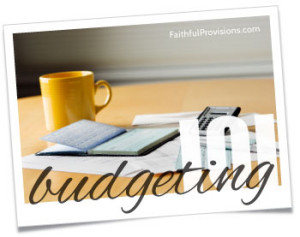
For more budgeting articles in this series, click HERE.
Budgeting Step Four: Savings and Emergency Funds
You are really getting on track now with budgeting! Step four: Savings and Emergency Funds, is probably the most practical and easiest to understand concept of budgeting. Everyone finds out pretty early in life that things don’t always go as planned. The unexpected occurs. Accidents happen. Surprises–both good and bad–are a part of everyone’s journey. At the same time, part of being an adult is preparing for those unexpected events. Expecting the unexpected! That’s why you have savings and emergency funds.
Savings Fund
Deciding how much is going to go into your savings fund each month depends on your long term goals and your determination to reach them. For example, do you want to use it for vacation, big ticket items like a kitchen re-do, or for college funding? If you examined your financial goals in step two of this Budgeting 101 series, then you should have some direction as to what you want to do with your money.
How focused are you on your goals?
How passionate are you about changing your current financial situation?
How desperate are you to change your financial future?
Like anything else, the amount of passion and determination that you have focused on any desire will decide your success at achieving it.
:: Learn more about Budgeting and Saving Money on Faithful Provisions!
Dave Ramsey’s Emergency Fund
If we learned anything from Financial Peace University, it was the real benefit of Dave Ramsey’s basic emergency fun. When you decide to really tackle your debt issues, it seems like all kinds of financial needs arise. For example, you need an emergency car repair or a new set of tires. Your washing machine goes out. A child needs glasses. When these things happen, they can destroy your budget and your best intentions for paying off debt. With a basic emergency fund in place, you have the money on hand to take care of these problems and keep paying down your debt. Dave recommends having $1000 in a savings account for a small emergency fund. After you have paid down your debt, you’ll be ready to save toward a larger emergency fund.
In the house of the wise are stores of choice food and oil, but a foolish man devours all he has. ~Proverbs 21:20
Larger Emergency Fund Definition: This larger emergency fund should be 3-6 months’ worth of your living expenses. Your living expenses will be the most necessary items in your monthly budget statement that you completed from Budgeting Step 3 – Creating a Household Budget. It would include items like mortgage, utilities, and your monthly food budget–the most necessary items for living.
ACTION STEP: Budget for your beginning emergency fund of $1000. You may want to jumpstart your savings fund by having a garage sale, selling items on Craig’s List or eBay, or taking on some extra hours at work or a part-time job. Saving just $20 a week would have your emergency fund in place in one year’s time.
Ready? Let’s move on to Step Five: Getting Rid of Debt.
What has motivated you to get your savings account going? I would love to hear your experience with moving from a budget to establishing financial goals, and then the thrill of hitting those goals!
If you are viewing this in a reader or via email, click here for this post’s comments.



